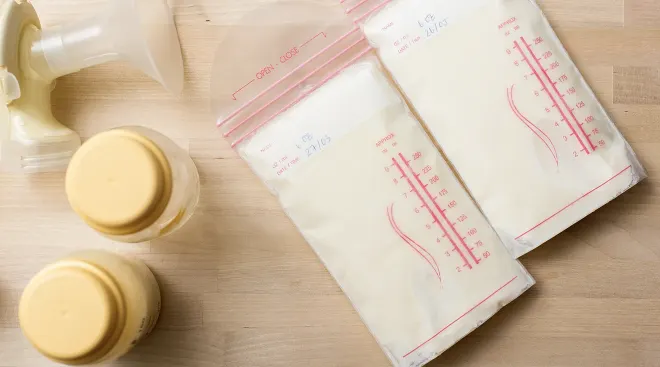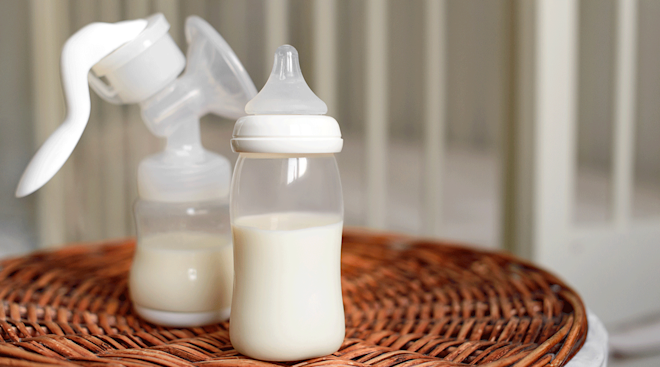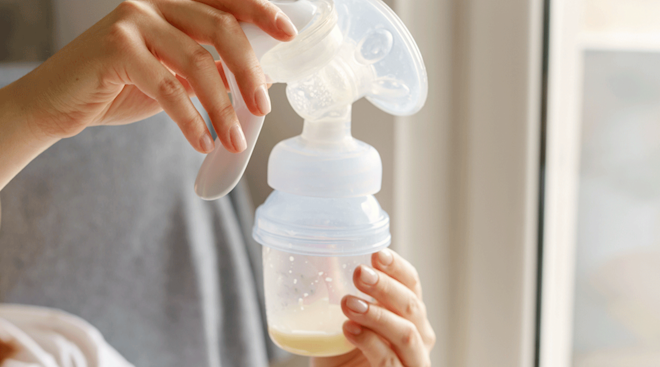6 Ways to Power Boost Your Breast Milk
It’s true: Breast milk is quite the superfood. What other form of nutrition automatically changes to meet baby’s needs and comes absolutely free? But even Mother Nature’s genius can be improved upon now and again. Read on for a few ways to give your milk a boost, from maximizing your output to improving its nutrition and ability to keep baby healthy.
These play an important role in baby’s brain, nervous system and vision development. One of the most important Omega-3 fatty acids is DHA, says the American Pregnancy Association (APA), which contributes to baby’s brain development during their first two years of life. Because DHA is transferred from Mom to baby through breast milk, it’s important that breastfeeding moms get enough of it—between 300 to 600 milligrams per day, the APA notes. One of the easiest ways to do this? With your daily diet. Fatty fish, like salmon (which is also low in mercury), is one of the best sources for getting additional DHA, as are walnuts and chia seeds, says Ashley Georgakopoulos, IBCLC, lactation director with Motif Medical. If you’re not a seafood fan, you can also chat with your doctor about taking a fish oil supplement or another Omega-3 supplement, adds Jessica Madden, MD, IBCLC, a board-certified pediatrician and medical director of Aeroflow Breastpumps.
It’s important for moms to eat a balanced diet with enough calories while breastfeeding, Madden says. After all, what you eat directly affects the quality of your milk—not to mention the fact that your body’s working overtime and burning approximately 500 extra calories a day. While there are plenty of foods that can maximize a healthy diet, many of them can also pull double duty to increase milk production. Known as galactagogues, these foods have been used for centuries to get milk flowing, the APA says. According to Georgakopoulos, galactagogues containing iron (more on this below), fennel, moringa and ashwagandha have been proven to support milk production, as they support key hormones such as prolactin. Some common galactagogues include fenugreek (a common ingredient in lactation teas), blessed thistle, alfalfa peas and oats. “Oatmeal is a wonderful source of iron fiber and energy—and typically quite affordable, as well as versatile in its uses,” says Georgakopoulos. Plus, along with flaxseeds, oats are a common ingredient in lactation cookies, which you can either buy online or whip up at home.
It’s no surprise that women can displace a lot of blood during pregnancy and childbirth, but what may be less well known is that blood supply and iron levels can impact breast milk production. Blood flow carries iron and oxygen to fuel the tissue responsible for producing breast milk, explains Georgakopoulos. “It also allows nerve endings to thrive, which are key to receiving the proper stimulation signals to produce, secrete and replenish milk.” If a breastfeeding mom has low iron, is anemic or has experienced significant blood loss, it’s important to address it early on. Georgakopoulos recommends eating iron-rich foods, such as red meats, green leafy vegetables, beans, legumes and whole grains (like oats), to ensure optimal milk production and supply. Of course, always check with your doctor before making any drastic changes or adding iron supplements to your diet.
Yes, your breast milk contains everything baby needs to grow and thrive, but new research suggests infants born today might be missing key gut bacteria needed to digest some of their nutrients. Research from the University of California shows that many babies lack B. infantis, good bacteria in the gut that helps digest breast milk and protects baby from potentially harmful bacteria that have been linked to colic, eczema, allergies and obesity down the road. But certain baby probiotics may help create a protective environment in the digestive system and contribute to baby’s metabolism and immune system. Not only can these probiotics can be added to expressed breast milk, but studies have found that breast milk actually helps preserve beneficial gut microbiomes—which are usually fleeting—for 30 days after the supplementation.
However, Madden says to read these studies with caution, as some of them may be biased. “I don’t think that it hurts to give probiotics to infants…but to my knowledge, most of the research on probiotics and infants is funded by companies that manufacture and market probiotics,” says Madden. “If you do choose to give baby probiotics, please make sure they are from a reputable company and formulated for infants.” Moreover, talk to your pediatrician before adding anything to your expressed breast milk or diet, as these small additions could lead to big changes in baby’s nutrition, Madden adds.
Possibly the most foolproof way to increase your milk supply is to feed or pump based on your child’s feeding cues—and this could even be every one to two hours for baby’s first few weeks. To establish a full milk supply early on, Madden recommends plenty of skin-to-skin contact, breastfeeding on demand and nursing or pumping at least eight to 10 times in a 24-hour period. “Middle-of-the-night breastfeeding sessions are especially important during the first few weeks, as prolactin levels are usually highest in the wee hours of the night,” she adds.
If you need more help boosting your supply, consider power pumping. This practice of spending an hour a day pumping in short bursts (pump 20 minutes, then rest 10 minutes, pump 10, rest 10, etc.) mimics cluster feeding, says Georgakopoulos. Power pumping can signal the body to produce more milk and help jump-start your supply if it starts to dwindle. Just be wary of doing this in the first few weeks postpartum, as it can create an oversupply and put moms at risk for clogged milk ducts and mastitis, Madden says. Speak with your doctor or a lactation consultant about how often you should be nursing or pumping to meet baby’s breastfeeding needs.
For the first six months of baby’s life, you’re their sole source of hydration. Since infants younger than 6 months old shouldn’t drink water, you’ll need to be drinking plenty for both of you. This is especially crucial since your body needs water to keep producing milk. So what’s the magic number of ounces? The amount you need can vary depending on weather, diet or exercise. The key is to drink whenever you’re thirsty, both experts say—and you’ll likely naturally become more thirsty while nursing. Pay attention to your thirst (even when you’re busy with baby), and keep a glass ready and waiting near the spot where you breastfeed every day. If you’re still looking for a magic number, the experts recommend breastfeeding moms drink between eight to 10 8-ounce glasses of water daily, and this includes water found in certain foods and other beverages. Don’t overdo it though, says Georgakopoulos, as drinking excess water won’t magically increase milk supply.
While these tips and foods can help boost milk supply, keep in mind that the most important thing is to take care of yourself with proper nutrition, hydration and proactively seek support, both experts say. “Have lactation help and support in place ahead of time (ideally before giving birth); learn a lot about lactation during pregnancy (to have realistic expectations about breastfeeding); and make sure to have plenty of help and support lined up for after the baby arrives,” Madden says. Ultimately, as long as baby’s feeding well and gaining weight, you’re doing just fine.
About the experts:
Ashley Georgakopoulos, IBCLC, has eight years of experience in lactation counseling and currently serves as the lactation director with Motif Medical. She received her bachelor’s degree in nutrition sciences from the University of Tennessee-Knoxville.
Jessica Madden, MD, IBCLC, is a board-certified pediatrician, lactation consultant and neonatologist at Rainbow Babies and Children’s Hospital in Cleveland, Ohio. She also currently serves as the medical director of Aeroflow Breastpumps, as well as the founder of Primrose Newborn Care. Previously, she has served as the clinical instructor of pediatrics at Harvard Medical School. She received her bachelor’s degree from the University of Notre Dame and her medical degree from Ohio State University. She completed her residency in pediatrics at the University of Massachusetts.
Please note: The Bump and the materials and information it contains are not intended to, and do not constitute, medical or other health advice or diagnosis and should not be used as such. You should always consult with a qualified physician or health professional about your specific circumstances.
Plus, more from The Bump:
Navigate forward to interact with the calendar and select a date. Press the question mark key to get the keyboard shortcuts for changing dates.





















































